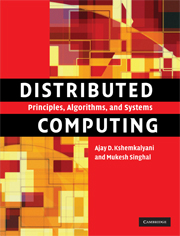Book contents
- Frontmatter
- Contents
- Preface
- 1 Introduction
- 2 A model of distributed computations
- 3 Logical time
- 4 Global state and snapshot recording algorithms
- 5 Terminology and basic algorithms
- 6 Message ordering and group communication
- 7 Termination detection
- 8 Reasoning with knowledge
- 9 Distributed mutual exclusion algorithms
- 10 Deadlock detection in distributed systems
- 11 Global predicate detection
- 12 Distributed shared memory
- 13 Checkpointing and rollback recovery
- 14 Consensus and agreement algorithms
- 15 Failure detectors
- 16 Authentication in distributed systems
- 17 Self-stabilization
- 18 Peer-to-peer computing and overlay graphs
- Index
6 - Message ordering and group communication
Published online by Cambridge University Press: 05 June 2012
- Frontmatter
- Contents
- Preface
- 1 Introduction
- 2 A model of distributed computations
- 3 Logical time
- 4 Global state and snapshot recording algorithms
- 5 Terminology and basic algorithms
- 6 Message ordering and group communication
- 7 Termination detection
- 8 Reasoning with knowledge
- 9 Distributed mutual exclusion algorithms
- 10 Deadlock detection in distributed systems
- 11 Global predicate detection
- 12 Distributed shared memory
- 13 Checkpointing and rollback recovery
- 14 Consensus and agreement algorithms
- 15 Failure detectors
- 16 Authentication in distributed systems
- 17 Self-stabilization
- 18 Peer-to-peer computing and overlay graphs
- Index
Summary
Inter-process communication via message-passing is at the core of any distributed system. In this chapter, we will study non-FIFO, FIFO, causal order, and synchronous order communication paradigms for ordering messages. We will then examine protocols that provide these message orders. We will also examine several semantics for group communication with multicast – in particular, causal ordering and total ordering. We will then look at how exact semantics can be specified for the expected behavior in the face of processor or link failures. Multicasts are required at the application layer when superimposed topologies or overlays are used, as well as at the lower layers of the protocol stack. We will examine some popular multicast algorithms at the network layer. An example of such an algorithm is the Steiner tree algorithm, which is useful for setting up multi-party teleconferencing and videoconferencing multicast sessions.
Notation
As before, we model the distributed system as a graph (N, L). The following notation is used to refer to messages and events:
When referring to a message without regard for the identity of the sender and receiver processes, we use mi. For message mi, its send and receive events are denoted as si and ri, respectively.
More generally, send and receive events are denoted simply as s and r. When the relationship between the message and its send and receive events is to be stressed, we also use M, send(M), and receive(M), respectively.
- Type
- Chapter
- Information
- Distributed ComputingPrinciples, Algorithms, and Systems, pp. 189 - 240Publisher: Cambridge University PressPrint publication year: 2008



